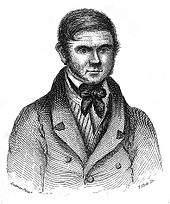
Word of the Day: Burke
Burke: Word of the Day
The www.alphadictionary.com word of the day for today is burke (bɜrk—just like bird, except for the last consonant sound). It’s a verb, so we should say, “To burke,” and it is spelled with a short b. According to www.dictionary.com, it means either “to murder, as by suffocation, so as to leave no or few marks of violence” or “to suppress or get rid of by some indirect maneuver.” Alphadictionary elaborates on the second definition: “To cover up, to sweep under the rug, to quietly suppress, as politicians are wont to burke investigations into their wrongdoing.” But it then adds, “The [second] definition of today’s word has many applications outside the field of politics: ‘To make the film even more depressing, the director burked all the elements that might have even faintly curled the lips of the audience.’”
Alphadictionary provides the history of the word thus: “The eponym of today’s word was an Irishman, William Burke who, with his accomplice, William Hare, was executed in Edinburgh in 1830 for suffocating 16 people in order to sell their bodies to the Edinburgh Medical School for dissection. He received £7 10/- each for his wares, an excellent price even considering the extra work he performed. He was arrested with accomplices almost by accident, no suspicions having been raised by his seemingly limitless stock and overnight service.” The two started out by selling the body of a boarder, living with Hare, who died of natural causes. To make up for back unpaid rent, they decided to try to sell the body at the University of Edinburgh, one of the leading schools for studying anatomy in the world at that time. They were thanked and told that they would be welcome back any time—there was a real shortage of available corpses for study. But after a while, the pair got a bit carried away with helping out the sciences.
On this date in 1934, Sergei Kirov was murdered in Leningrad. Kirov was one of the “Old Bolsheviks,” having been part of the revolutionary movement going back to 1904. He was a friend of Lenin and Stalin. He was a military leader in the Russian Civil War of 1917 to 1920, known for his merciless suppression of anyone who hid money or goods from his troops.
After the Revolution and the Civil War, he was first the party leader in Azerbaijan and then, starting in 1926, the leader of the party in Leningrad. He was a staunch Communist and believer in forced collectivism, but he also acted independently at times. Therefore, many believe that Stalin had him murdered. Whether that is true or not, Kirov’s murder led to the Great Purge of 1934-38.
Stalin, getting progressively more paranoid, used the murder of his old friend to purge the Communist Party of anyone he thought might disagree with him about pretty much anything. He staged what later became known as the Moscow Trials, during which party members confessed to being spies and were sentenced to death.
During the Purge, according to the estimates of some historians, 30,000 members of the Red Army were executed, including 81 of 103 generals and admirals. In addition, Stalin signed a law that made families responsible for the betrayal of the men, so children as young as 12 were executed as traitors. Of the roughly 3 million party members, about a third were purged in the course of the four years. Many were sent to the Gulags. Estimates of the dead from the Great Purge range from 750,000 to 1.5 million.
Keep in mind that this number is in addition to the millions who killed in the Holodomor of 1932-33.
After the Russian Revolution, the communists proposed something called democratic centralism, defined by Wikipedia like this: “Democratic centralism is a Leninist democratic practice in which political decisions reached by voting processes are binding upon all members of the party.” During the Civil War, Lenin was granted dictatorial powers because of the needs of the war, but after the Civil War was over, many members of the party felt that it was time for democratic centralism to take hold. Stalin, who took over as the dictator even before Lenin’s death in 1924, was happy with complete power and objected to anyone who wanted him to share. As a result of this disagreement, hundreds of thousands of people, maybe millions of people, died.
Leaders today are not able to simply murder, through show trials and gulags, the people who disagree with them. They have to be subtler, more secretive. They have to suppress the opposition by some indirect maneuver. They have to “cover up, to sweep under the rug, to quietly suppress, as politicians are wont to burke investigations into their wrongdoing.” Then again, some leaders, like college presidents and provosts, can just refuse to talk about their wrongdoing and seem to able to get away with it.
The image is a drawing of William Burke as he appeared at the bar. Taken in Court. George Andrew Lutenor; a portrait painter who was also one of the jurors at William Hare’s trial – Anon (1829), West Port Murders, or An Authentic Account of the Atrocious Murders Committed by Burke and His Associates, Edinburgh: Thomas Ireland Junior (facing title page)